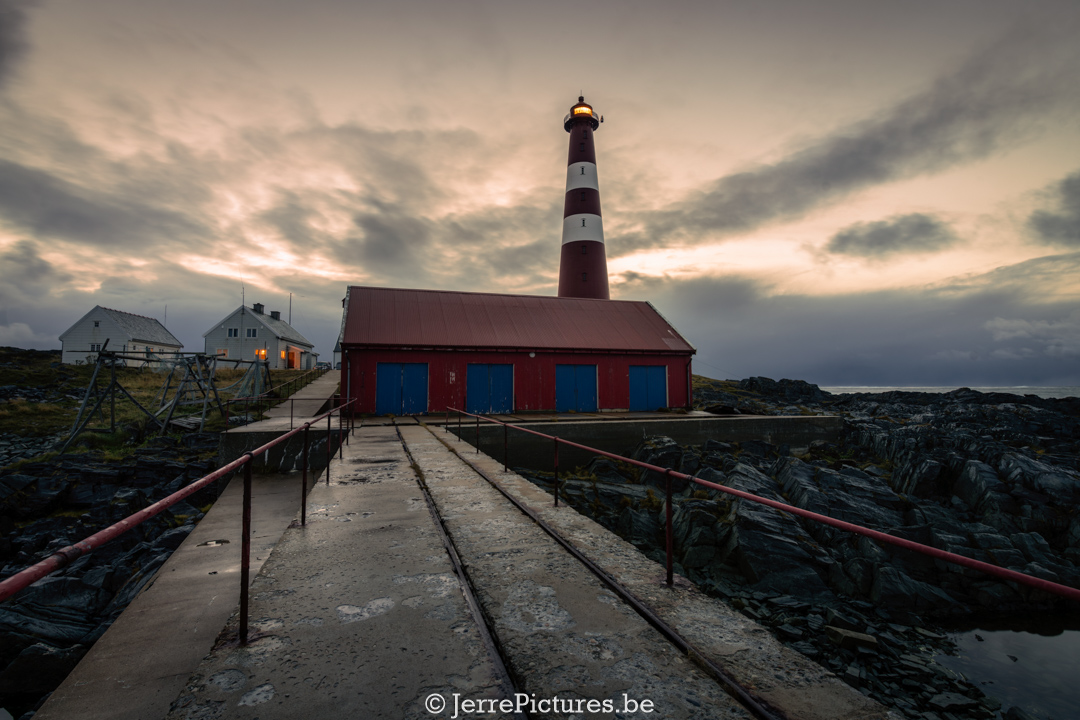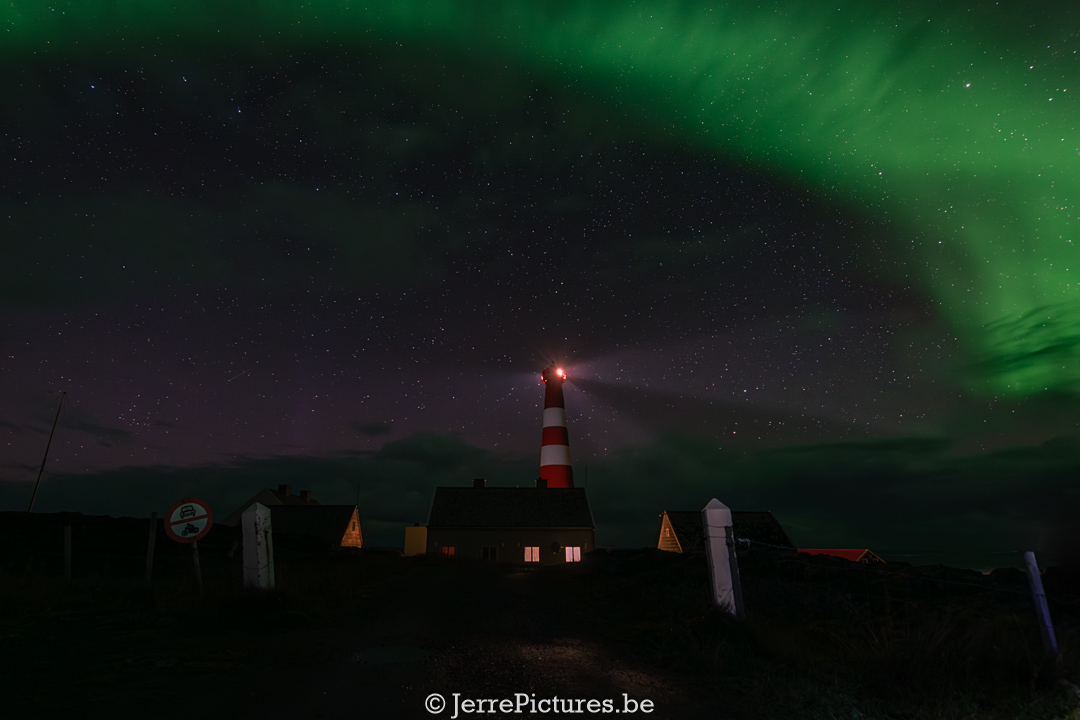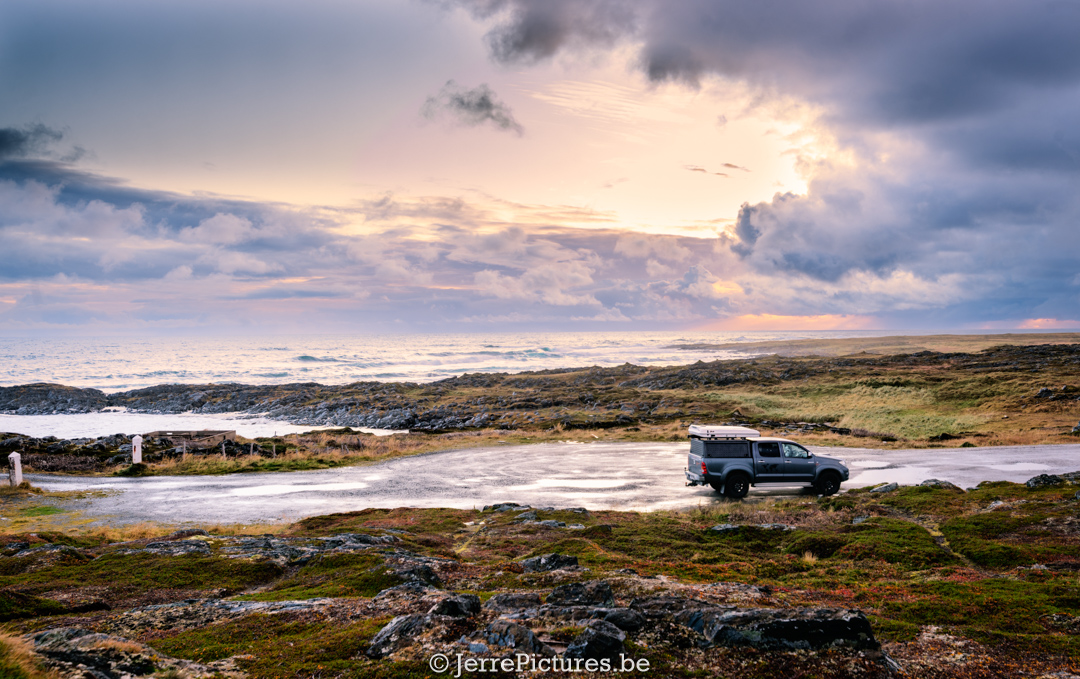 On a modest, cold evening, I reached the world’s northernmost lighthouse on the mainland, slettnes fyr (Slettnes Lighthouse). Darkness fell quickly, so I decided to postpone my dinner and take some photos first. I could still feel the fatigue in my legs from the previous evening; you could say I had a wild night out, okay, I didn’t get much sleep. But it’s a slightly different story. I was forced to flee from a pack of wolves. (That story alone is worth a post.) I was just in the wrong place at the wrong time, and I didn’t want to experience that again.
On a modest, cold evening, I reached the world’s northernmost lighthouse on the mainland, slettnes fyr (Slettnes Lighthouse). Darkness fell quickly, so I decided to postpone my dinner and take some photos first. I could still feel the fatigue in my legs from the previous evening; you could say I had a wild night out, okay, I didn’t get much sleep. But it’s a slightly different story. I was forced to flee from a pack of wolves. (That story alone is worth a post.) I was just in the wrong place at the wrong time, and I didn’t want to experience that again.
Despite the icy cold and the biting wind, I truly enjoyed the moment. When I decided I had taken enough photos, I lowered the tailgate of my 4×4 to prepare my evening meal. As I looked up at the sky and felt the cold, I said to myself, “It feels strange. When the wind feels like this (innerfeeling), I usually see the Aurora Borealis.” I hoped the clouds would clear a bit more, and that I could have a nice evening.
While I was cooking, my thoughts wandered to the perfect photo I wanted to capture, something that doesn’t happen often when it’s this cold. Until… suddenly I was startled by rustling. I thought to myself, “Not again,…” But there, suddenly, stood a young fox. It showed no fear of my presence and sat down about five meters away, waiting. It was clear that tourists had probably fed this little creature in the past. I didn’t understand why people couldn’t just let wild animals be wild.
Despite the advice from animal welfare organizations not to feed wild animals, some people still do. Why? I tried to shoo the little fox away by hissing and stamping my foot firmly on the ground, but it had no effect at all! I decided to ignore it but remained cautious, expecting the mother to suddenly appear with her cunning fox tricks. But that didn’t happen. The icy wind picked up, or maybe it was just fatigue, and I decided to bundle up and sit in front of my car. According to an app I was using, there was a KPI index of 3+, which usually indicates a chance of seeing the Northern Lights (Aurora Borealis) at this latitude.
I didn’t have to wait long. Around 11 o’clock, I saw faint feathertail clouds appear. But what many people don’t know is that these are not feathertail clouds, but a sign that the Aurora Borealis is present. If you point your camera at them for a few seconds, you’ll see that these clouds turn green on the camera, although the color is not visible to the naked eye. I took out my camera and positioned myself so that I could observe the Aurora Borealis above the lighthouse. And then I hoped that the Aurora Borealis would break through…
However, while I was setting everything up, I heard rustling again in the pitch darkness. It was just enough to gave me some goosebumps… You can probably guess – there was the little fox again. I wasn’t entirely comfortable with wild animals around me at night, but I tried to ignore it. However, the fox kept staring at me, as if it wanted something from me.
I tried to ignore it as much as possible because I really wanted to capture a photo with the Northern Lights. The northern lights eventually broke through, but not in the way I had hoped. It appeared only for brief bursts of 15 to 20 seconds at a time, never directly above the lighthouse. It was so frustrating because it could have been an amazing shot.
I also didn’t want to stay too far from my car for a potentially better position, considering the adventure from the previous night was still fresh in my memory, and I still felt quite uncomfortable. I knew that wolves usually don’t do anything, but a whole pack… You Never Know…
While trying to process my disappointment over the less-than-ideal Northern Lights shot, I noticed something. The little fox that had been wandering around me all this time started playfully jumping around as if the Northern Lights were a disco. I smiled as I watched the little fox pulling off crazy tricks, and I realized that some things don’t need to be captured on camera to be appreciated. Sometimes, the most special moments are the ones that exist only in our memories.
With a sense of satisfaction and gratitude, I returned to my car. While my Northern Lights photo may not have turned out as I had hoped, I had received something much more precious: an unexpected encounter with the wild beauty of nature and a bond with a curious fox that showed me that some moments are simply unforgettable without the intervention of a lens.
Regarding Slettnes Fyr:
IS IT ACCESSIBLE WITH A CAMPER?
If you drive carefully, the road is accessible even for campers. Keep in mind that only a few vehicles can park here! During the season, there are usually a few campers for overnight stays.
WEATHER:
On average, temperatures during the summer months (June, July, and August) range from approximately 5°C to 15°C. These are the warmest months of the year, but it can still feel quite cool, especially due to the influence of the nearby ocean.
In the winter months (December, January, and February), temperatures can drop below freezing, with average temperatures ranging from approximately -5°C to -15°C.
The Barents Sea partially freezes in winter, especially in the northern parts close to the coast of Norway and Russia. However, the water in the Barents Sea is generally relatively warm due to the influence of the Gulf Stream, a warm ocean current that comes from the Atlantic Ocean. As a result, a large part of the Barents Sea remains ice-free in winter, even in the northern regions.
However, in the coldest months of the year, ice can form in the coastal areas of the Barents Sea, including parts of the Norwegian coast. This ice formation can vary from year to year depending on specific weather conditions and temperatures. In some years, the ice may extend further than in other years, temporarily partially or completely freezing the sea.
Stay in an Enchanting Lighthouse – Slettnes Fyr
Do you dream of sleeping in a unique and enchanting location? Find tranquility in the historic Slettnes Fyr lighthouse, situated along Norway’s breathtaking coastline. Awaken to the sound of waves and indulge in panoramic ocean views. Book your stay here:
An experience you’ll never forget!
A nerdy deep dive into Slettnes fyr:
Let’s start with a fun fact, Slettnes fyr is located approximately 70 km (43.5 mi) as the crow flies from Nordkapp, but if you want to drive (or walk) there, you’ll have to cover a distance of 438 km (272 mi), which takes about 6.5 hours driving without stops—although it’s nearly impossible not to stop considering all the beauty you encounter along the way.
There you have it! The answer to the question. Many folks often believe that the Kjølnes lighthouse in Gamvik, Norway, on the island of Magerøya, is the northernmost lighthouse on the mainland. However, upon closer examination of the coordinates, it becomes clear that the Slettnes lighthouse (Slettnes fyr) actually holds that title. Situated at approximately 71.0789° N latitude, the Slettnes fyr is slightly farther north than the Kjølnes lighthouse, which stands at around 70.9877° N latitude.
Now, let’s talk about the Knivskjellodden Lighthouse. Although its coordinates (Latitude: 71.1857° N & Longitude: 25.7844° E) might suggest it is the northernmost lighthouse, it’s not entirely accurate. This lighthouse is located on the Knivskjellodden peninsula, which is connected to the island of Magerøya. Since Magerøya is connected to the mainland through a tunnel, I consider it an island, and therefore, I maintain that the northernmost lighthouse on the mainland is the Slettnes fyr.
However, if we broaden our perspective beyond the mainland, we discover the world’s northernmost lighthouse on the remote island of Magerøya in the Arctic Ocean. This lighthouse, known as the Knivskjellodden Lighthouse, stands tall on a cliff at the northern tip of the island. It serves as a vital navigational point for ships traversing the Arctic Ocean.
So, while the Slettnes fyr proudly holds the distinction of being the northernmost lighthouse on the mainland, the Knivskjellodden Lighthouse on Magerøya Island claims the title of the world’s northernmost lighthouse. Spoiler alert: The Knivskjellodden Lighthouse is actually just a few cubic meters in size.
While exploring the enchanting beauty of the Slettnes lighthouse, it’s interesting to realize that there are more northern lighthouses supporting navigation and safety at sea. These lighthouses serve as beacons of light in the vast northern waters, and their historical and functional significance makes them fascinating destinations for adventurous travelers and maritime history enthusiasts.
The Slettnes lighthouse, constructed between 1903 and 1905, is situated in a remote location on the coast of the Barents Sea. Rising approximately 35 meters high, the lighthouse stands majestically atop a cliff, overlooking the vast ocean. It is one of the oldest operating lighthouses in Norway. The first lighthouse keepers to serve at Slettnes fyr were Olaus Nikolai Danielsen and his wife Ingeborg. They moved to this secluded place to man the lighthouse and take care of the light and equipment.
In 1929, the original wooden lighthouse was replaced with a new concrete tower. This relocation was necessary as the original location was too close to the cliff edge, posing a risk of erosion. This lighthouse stood its ground for a while, fulfilling its valuable role until 1944 when retreating German troops blew up the station, but the lower part of the lighthouse remained intact. As a result, Slettnes is now the only cast-iron tower in Finnmark—the other lighthouses were rebuilt in concrete. In 1998, the lighthouse was protected as a cultural monument.
In 2005, the Slettnes lighthouse underwent automation, rendering permanent lighthouse keepers unnecessary. The light and other equipment are now operated remotely. The main function of the lighthouse is to mark the northern entrance of the Barents Sea and guide ships navigating through this area. The lighthouse’s light has a range of approximately 17 nautical miles, which is crucial for ship navigation in these challenging and rugged waters.
In addition to its maritime function, the location of the Slettnes lighthouse offers breathtaking views of the surrounding natural landscapes, with rocky coastlines and imposing mountains in the background. For many people, it becomes one of their favorite destinations once they have been there. Even though the road to reach it is not a paved one, it adds to the adventure, enhancing the appeal of the lighthouse as a remote beacon.
As a historical and cultural heritage, the Slettnes lighthouse is a tangible reminder of Norway’s rich maritime history. Visitors can tour the lighthouse and explore the accompanying visitor center. The center is typically open only during the tourist high season, which usually runs from June to August. Here, visitors can learn more about the history and function of the lighthouse. It is a unique place to experience, especially for lovers of maritime history and stunning coastal landscapes.
The area surrounding Slettnes Fyr is not only a paradise for birdwatchers but also an area of importance for nature conservation. It provides a refuge for diverse bird species, including the majestic golden eagle, and is surrounded by protected natural areas that contribute to the preservation of flora and fauna.
There are special bird hides in the vicinity designed to offer birdwatchers an optimal experience. From these hides, they can peacefully and comfortably enjoy observing birds in their natural habitat. In addition to the golden eagle, birdwatchers can spot rare migratory birds and native bird species that consider the area their home. Here are some examples:
Atlantic Puffin (Fratercula arctica): This iconic seabird is known for its colorful beak and its ability to “fly” underwater using its wings while searching for fish.
Razorbill (Alca torda): Another well-known seabird, recognizable by its black-and-white plumage and bright red beak. Razorbills often nest on cliffs and spend their time at sea, where they feed on fish.
Arctic Tern (Sterna paradisaea): This elegant migratory bird has long, slender wings and is known for its impressive annual migrations from Arctic breeding grounds to Antarctic waters.
Common Eider (Somateria mollissima): A large sea duck with distinctive plumage. The male has a white breast and black head, while the female has a brown plumage. Common eiders often breed in colonies along the coast.
Black-legged Kittiwake (Rissa tridactyla): A small gull species with a black head, white feathers, and yellow legs. They nest on cliffs and primarily feed on fish.
Snow Bunting (Plectrophenax nivalis): A songbird that migrates to the coastal areas of Norway during winter. The male has a white plumage with black stripes, while the female has a more grayish color.
In addition to these bird species, there are many more birds you may encounter depending on the season and specific conditions.
While Slettnes Fyr itself is not an officially protected nature reserve, it contributes to the value and significance of the surrounding protected areas. It is a place where birds and other animals thrive, coexisting with the natural environment. can thrive and where nature enthusiasts have the opportunity to enjoy the beautiful diversity of Norwegian fauna.
As visitors, it is essential to respect the local rules and guidelines regarding nature conservation. Through responsible behavior and respect for the environment, we can contribute to the preservation of these valuable natural areas, so that future generations can continue to enjoy the stunning birds and breathtaking landscape around Slettnes Fyr.


